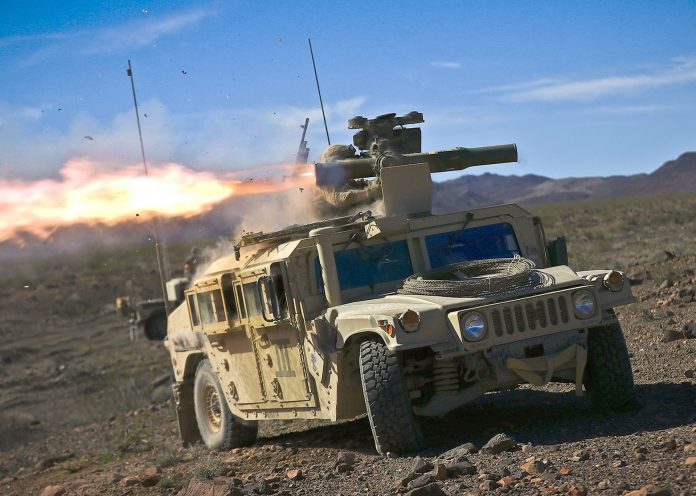
Working with the U.S. Marine Corps, U.S. Army engineers at Picatinny Arsenal have developed a new armored turret to provide greater survivability to TOW missile gunners without heaping extra weight on vehicles.
The venerable TOW missile takes its name from Tubed-launched, Optically-tracked, Wire-guided. A spool of wire, thousands of meters long, unwinds while the missile is in flight. Guidance data passes through the wire in real time, allowing the gunner to accurately steer the missile to its final destination. The firing sequence takes time, and the gunner’s confidence level must remain high.
The new TOW Objective Gunner Protection Kit (TOGPK 2.0) turret provides just the right balance of armor, situational awareness and weapon maneuverability to fight effectively, according to engineers at Picatinny.
Firing the TOW Missile is not a trivial operation. First, the gunner must confirm the target with absolute certainty. The weapon sights are then precisely aimed down range. The trigger is pulled and suddenly an intense shock wave fills the air. The missile is in flight. Now the gunner maintains full composure to patiently and steadily guide the missile directly to the target.
The Marines who operate this weapon can attest to its power. They are well-trained experts who deliver extreme amounts of energy on target.
“The TOGPK 2.0 is the latest turret that we developed jointly with the U.S. Marine Corps,” explained Thomas Kiel, who leads the engineering design of armored turret systems at Picatinny Arsenal. “The Marine Corps is an exceptional fighting force with very high expectations. Our close partnership with experienced warfighters during the design phase was especially helpful in meeting their needs.” Picatinny worked closely with the Marine Corps System Command, which has the ultimate decision authority over the requirements and final solution.
The Combat Capabilities Development Command Armaments Center, with headquarters at Picatinny, is responsible for designing protective turrets for tactical vehicles. These armored kits greatly enhance survivability, while allowing gunners to focus on their mission objectives.
The TOGPK 2.0 design utilizes new armor materials that were derived from the Combat Capabilities Development Command Army Research Laboratory. Lightweight and highly effective materials are pursued that provide the stopping power required without overburdening the vehicles with extra weight.
The new turret system will be fielded with the new Joint Light Tactical Vehicle (JLTV), which is the Humvee replacement. The Armaments Center has developed a number of protective turrets for military vehicles including Humvee, Mine Resistant Ambush Protected (MRAP) and Stryker. Tens of thousands have been fielded to protect gunners against persistent threats.
In particular, the Objective Gunner Protection Kit (OGPK) turret, also developed by the same Picatinny team, currently is in use by every branch of the U.S. Armed Forces as well as over 20 international coalition partners. The OGPK integrates well with the .50 caliber weapon along with the 40mm grenade launcher and other weapons. The Army has adopted the OGPK as the standard turret for the new JLTV Heavy Guns Carrier (HGC).
“The absolute first priority with all of our turret systems is protection for the warfighter,” said Kiel. “At the same time, we strive to provide the best solutions that enable our gunners to fight decisively.”
The Close Combat Weapons Carrier (CCWC) variant of the JLTV integrates the TOGPK 2.0 turret and TOW missile system.
“We develop our turret solutions in-house at the Armaments Center,” said Narayan Bhagavatula, Product Director for Gunner Protection Systems. “This allows us to maintain full ownership of the designs and ultimately makes the system more affordable in production,” he continued. Cost savings come from the ability to attain competitive bids for the fabrication of the turrets within the U.S. industrial base, both organic and private.
Project Manager Soldier Lethality manages the acquisition of the turrets, while the design activity is maintained within the Armaments Center.
“The talent pool that exists at Picatinny is unmatched anywhere,” said Kiel. “For example, our highly skilled machinists at our Prototype Integration Facility provide tremendous support in making sure that our designs can be manufactured easily.” The PIF at Picatinny Arsenal includes state-of-the-art machinery for processing armor materials and generating sophisticated prototypes for test and evaluation.
Picatinny Arsenal, located in northern New Jersey, provides a wide variety of guns, ammunition, products and related services to all branches of the U.S. military.
from Defense News by DefenceTalk.com https://ift.tt/36mfLaH
via Defense News
No comments: